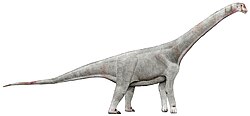| Cerro Barcino Formation | |
|---|---|
| Stratigraphic range: Aptian-Cenomanian ~ | |
| Type | Geological formation |
| Unit of | Chubut Group |
| Sub-units | Las Plumas Cerro Castaño Puesto La Paloma Bayo Overo |
| Underlies | Puesto Manuel Arce Formation |
| Overlies | Los Adobes Formation |
| Lithology | |
| Primary | Mudstone, sandstone |
| Other | Conglomerate, tuff |
| Location | |
| Coordinates | 43°48′S68°36′W / 43.8°S 68.6°W |
| Approximate paleocoordinates | 44°42′S35°06′W / 44.7°S 35.1°W |
| Region | Chubut Province |
| Country | Argentina |
| Extent | Cañadón Asfalto Basin |
| Type section | |
| Named for | Cerro Barcino |
The Cerro Barcino Formation (also known as the Gorro Frigio Formation) is a geological formation in South America whose strata span the Early Cretaceous to the earliest Late Cretaceous. The top age for the formation has been estimated to be Cenomanian. Earlier estimates placed the formation until the Campanian. [1]
Contents
The formation was deposited in the Cañadón Asfalto Basin, a rift basin that started forming in the earliest Jurassic. Dinosaur remains are among the fossils that have been recovered from the formation.
The Cerro Barcino Formation is the second-youngest unit of the Chubut Group, which also includes the older Los Adobes Formation. Both formations cover a vast area in Chubut Province, Argentina. The two formations are distinguished by geological features suggesting a distinct change in climate, from a wetter, flood plain environment in the Los Adobes to a much more arid, desert-like environment in the Cerro Barcino. [1]
The Cerro Barcino Formation is subdivided into several subunits (members). [1] From oldest to youngest:
- Bayo Overo (Correlates with both the Puesto La Paloma and the Cerro Castaño members)
- Puesto La Paloma
- Characterized by arid plains interspersed with sand dunes
- Cerro Castaño
- A return to more humid, flood-plain conditions
- Las Plumas
The Puesto La Paloma Member dates from ~118-113 Ma, the Cerro Castaño Member dates from ~113-100.5 Ma, correlating with the Albian, and the Las Plumas Member dates from ~100.5-98 Ma. [2]




